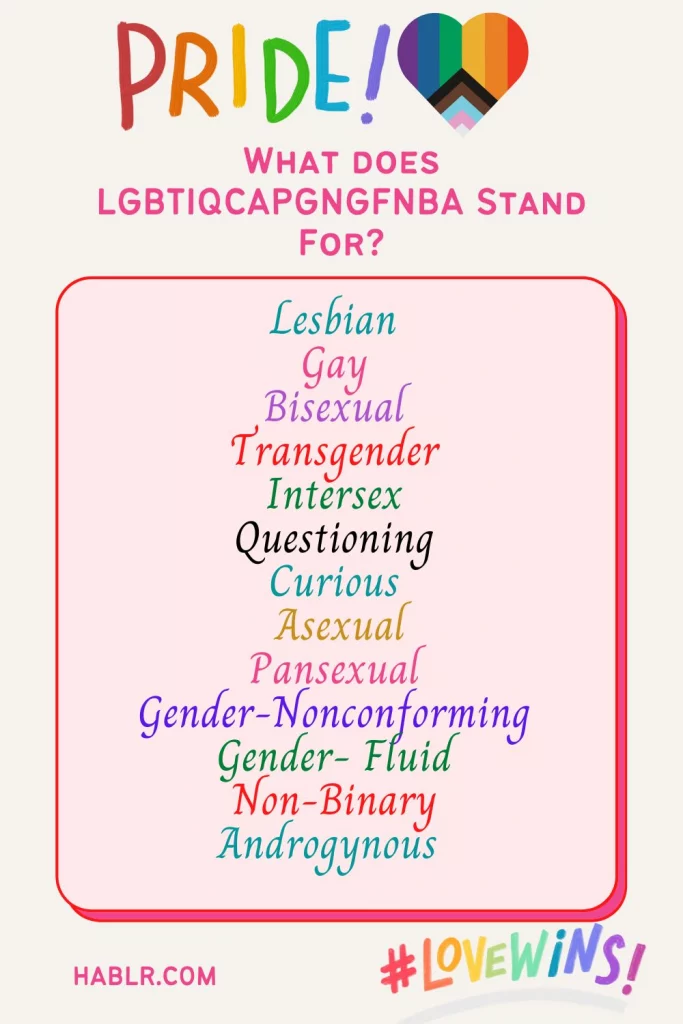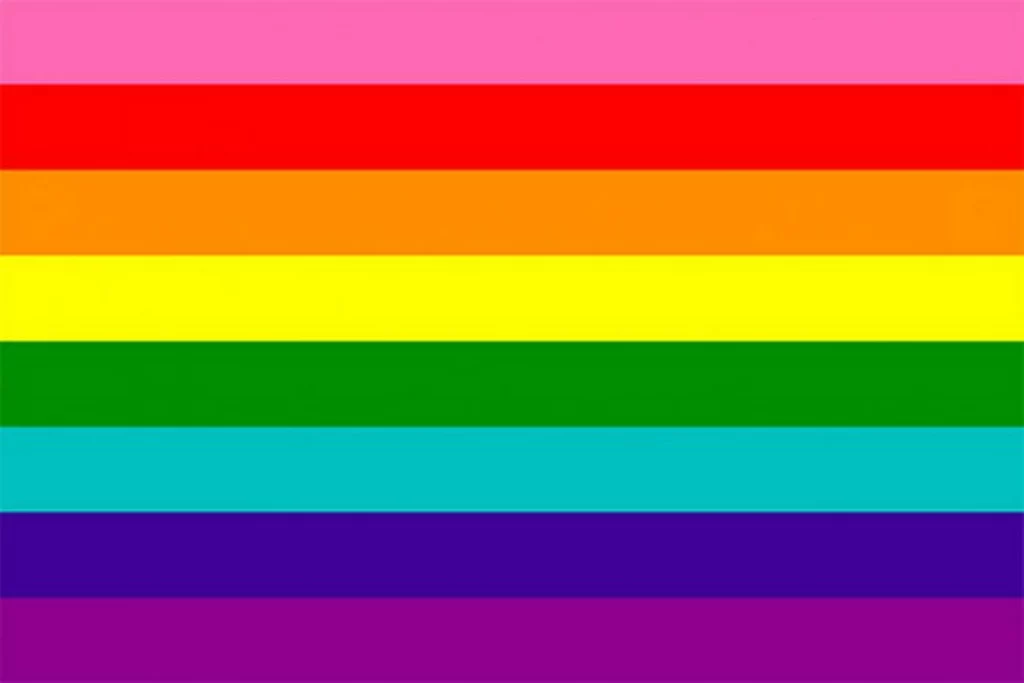If you’re looking for the full definition of LGBTIQCAPGNGFNBA with each term explained, you’re in the right place!
The LGBT community which stands for Lesbian, Gay, Bisexual, and Transgender – is one of the most diverse groups of people in the world that incorporate people’s sexual orientation and their gender choice. However, that phrase itself is a needle in a haystack.
Ever since the uprising of terms such as LGBT that represent the diverse sexual orientations and genders of people, every year there are newer and longer terms that come into existence so that even the very niche people who may or may not be a part of the LGBT community can feel involved.
What does LGBTIQCAPGNGFNBA stand for?
Table of Contents
It is probably the longest abbreviation that includes almost all the other diversified categories of the community.
LGBTIQCAPGNGFNBA stands for Lesbian, Gay, Bisexual, Transgender, Intersex, Questioning, Curious, Asexual, Pansexual, Gender Nonconforming, Gender- Fluid, Non-Binary and Androgynous.
LGBTIQCAPGNGFNBA is an acronym used to represent the diverse range of sexual orientations and gender identities that exist within the LGBTQ+ community. The letters stand for:
L – Lesbian G – Gay B – Bisexual T – Transgender I – Intersex Q – Queer C – Curious (or questioning) A – Asexual P – Pansexual G – Genderqueer N – Non-binary G – Gender non-conforming F – Femme (or female-presenting) N – Non-binary femme B – Butch (or male-presenting) A – Androgynous

Out of the 13 letters in the term LGBTIQCAPGNGFNBA, 7 letters are for the terms related to sexual orientation and 6 are pertaining to gender identities.
Below I will list out the various sexual orientations and identities that are covered under LGBTIQCAPGNGFNBA and give a brief explanation of what they are:
Recommended Video: Sexual orientation? Gender identity? What’s the difference?
Sexual Orientations Under LGBTIQCAPGNGFNBA
Sexual Orientation is the term that is used to define who a person wishes to form romantic relationships with. An individual if they wish can be sexually attracted to anyone regardless of their gender. There are some categories that define sexual orientation.
- Lesbian – A homosexual woman who is not sexually attracted to men, i.e. is not straight and instead is attracted to the same sex or other women. Lesbians are only attracted to other women and no other gender.
- Gay – A homosexual man who is not sexually attracted to other women, i.e. is not straight and is only attracted to the same sex or other men. Gays are only attracted to men and not any other gender.
- Bisexual – Person(s) who is romantically or sexually attracted to both men and women or more than one gender. Bisexuals do not mind their gender and can be straight or gay.
- Questioning – Individuals who are unsure of who they wish to form romantic connections with and are still exploring are called Questioning. These people are in the stage where they still aren’t sure about their sexual orientation or their identities.
- Curious – These people are not specifically bisexual or Questioning but instead are curious about forming relationships with other men and women.
- Asexual – People who have no sexual desire. These individuals are not sexually attracted to any specific gender, however, they can form relationships or be interested in other people.
- Pansexual – People who are attracted to all sexual orientations, i.e. they do not care about gender and are romantically open to anyone regardless of gender.
Recommended Reads: What does LGBTQQIP2SAA stand for? Each Letter Explained
Gender Identities Under LGBTIQCAPGNGFNBA
Gender identity is what one perceives to be their sex. It can be the same as birth or it can differ according to the sex the person later wants to later identify themselves as.
- Transgender – People who choose to change their gender identity later after birth. They willingly want to live the other gender’s lifestyle or have personality traits like the sex opposite to what they were born with.
- Intersex – Individuals who are born with sex characteristics that may belong to both men and women. Persons who share genitals, chromosomes, or gonads with both genders are intersex.
- Gender Nonconforming – A person who doesn’t wish to identify with the gender that society has since decided by birth or characteristics.
- Gender-Fluid – An individual who doesn’t consider themself as a specific gender and is fluid between both men and women.
- Non-Binary – People who identify as neither men nor women and consider themselves to be an entirely separate gender.
- Androgynous – People who conform to both masculine and feminine characteristics.
Read: What does LGBTQIAPK stand for? Each Letter Explained
LGBTIQCAPGNGFNBA Flag

There is no specific flag that represents the entire LGBTIQCAPGNGFNBA community, as this acronym is quite long and includes a diverse range of identities. However, there are various flags that represent different aspects of the community, such as:
The rainbow flag is perhaps the most well-known flag representing the LGBTQ+ community. It features six colored stripes (red, orange, yellow, green, blue, and purple) and represents diversity and inclusivity.
The transgender flag, features a light blue stripe, a pink stripe, and a white stripe. Light blue represents the traditional color for baby boys, pink represents the traditional color for baby girls, and white represents those who are intersex, transitioning, or who identify with a neutral or undefined gender.
The asexual flag features four horizontal stripes: black, gray, white, and purple. The black stripe represents asexuality, the gray stripe represents gray asexuality and demisexuality, the white stripe represents sexuality, and the purple stripe represents community.
The non-binary flag features yellow, white, purple, and black stripes. The yellow stripe represents non-binary people who identify outside of the gender binary, the white stripe represents non-binary people who identify with multiple genders, the purple stripe represents non-binary people who feel their gender is a combination of male and female, and the black stripe represents non-binary people who feel their gender is undefined or unknown.
Here’s How to be a Better LGBTQ+ Ally:
Being an LGBTQ+ ally is about fostering genuine empathy, understanding, and love. By taking these heartfelt actions, you can create a world where everyone feels seen, accepted, and valued for who they are.
- Educate Yourself: Take the time to immerse yourself in the stories, experiences, and history of the LGBTQ+ community. Approach learning with empathy and an open heart, seeking to understand the challenges they face and the progress that has been made. By educating yourself, you show a genuine commitment to empathy and inclusivity.
- Listen and Learn: Create a safe and supportive space for LGBTQ+ individuals to share their journeys and experiences. Listen with an open mind and heart, without judgment or assumptions. This active listening allows you to learn from their unique perspectives, fostering deeper understanding and connection.
- Use inclusive language: Respect and honor people’s chosen pronouns and gender identities. Make an effort to use inclusive language that affirms and respects their authentic selves. By doing so, you create an environment of acceptance, love, and validation.
- Support LGBTQ+ Rights: Advocate for equal rights and protections for LGBTQ+ individuals. Stand beside them in the fight against discrimination and inequality. Support organizations and initiatives that promote inclusivity and work towards a more equitable society.
- Stand Up Against Discrimination: Be a vocal ally by challenging homophobic, transphobic, or discriminatory remarks and actions. Use your voice to speak out against prejudice and injustice. By actively standing up against discrimination, you demonstrate your commitment to a world where everyone can thrive.
- Show up and celebrate: Attend LGBTQ+ events, pride parades, or rallies to show your support and solidarity. By being present and visible, you affirm the importance of love, acceptance, and diversity. Celebrate the vibrancy and resilience of the LGBTQ+ community and amplify their voices and experiences.
- Reflect and Grow: Engage in self-reflection and introspection to uncover any biases or prejudices you may hold. Challenge yourself to grow and evolve, constantly striving to be a better ally. Embrace discomfort as an opportunity for personal growth, and be open to learning from your mistakes.
Recommended Reads:
